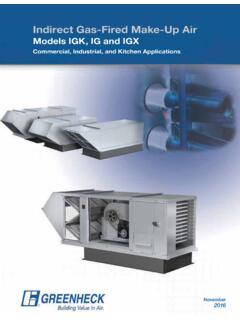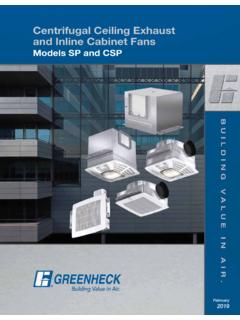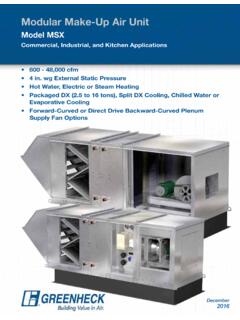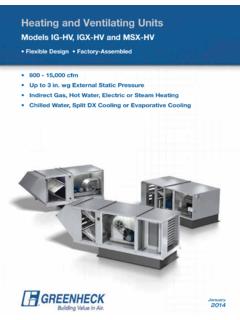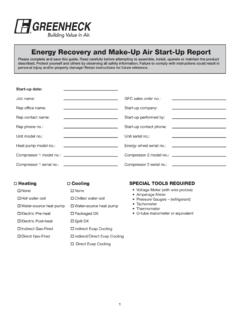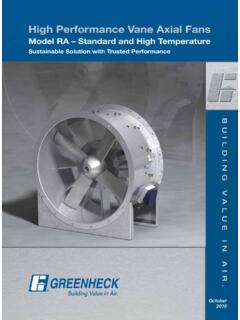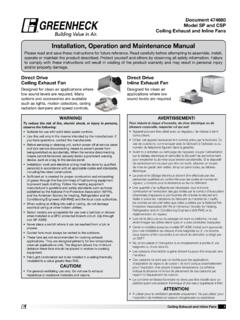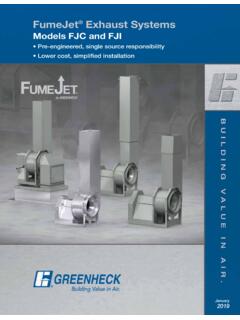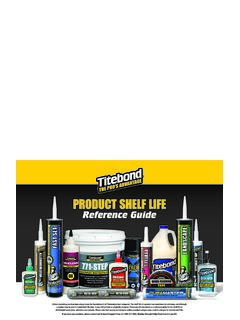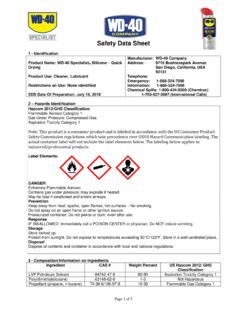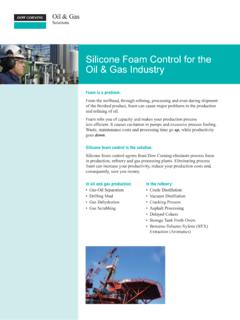Transcription of HVAC Control & Balancing Dampers - Greenheck-USA
1 1 HVAC Control & Balancing DampersModels VCD, ICD, FBH, FBV, MBD and RBD Selection Construction PerformanceJanuary20182 Design and Construction FeaturesAxleBearingBladeFrameLinkageJamb SealBlade SealStandoffBracketShaftExtension Frame OptionsThere are five frame options available: Channel (standard) - allows damper to be insert mounted into an opening or duct Single flange or single reverse flange - can be insert mounted or directly mounted to the wall or mating surfaces such as a plenum wall Double flange - when you are not sure which side you need a flange Quick connect (VCD-43, -43V; ICD series) - designed to match up to a TDC, TDF, or Ductmate connectionChannelFrameDoubleFlangeQuickC onnectSingleFlange(actuator side)SingleReverseFlange(opposite actuator)Commercial Control Dampers are used in buildings to regulate the flow of air in an HVAC system.
2 They can be used in intake, exhaust, or mixed air are two categories of Control Dampers : Balancing Volume ControlMaximize Performance - Low Profile FrameOn Dampers that are 17 in. (432mm) high or less, Greenheck uses a low profile top and bottom frame section to maximize free area which allows for lower pressure drop and increases damper Reinforced CornerFrame - Tog-L-Loc AdvantageGreenheck Control Dampers utilize a 5 in. x 1 in. (127mm x 25mm) hat channel frame. Each frame is built with four separate pieces of material and joined by our Tog-L-Loc frame - The joint has an equivalent thickness of 10 ga. ( ) corrosion resistance - The Tog-L-Loc process does not use heat, so Greenheck damper frames have greater corrosion resistance by retaining the galvanized frame for easier install - Using four separate frame components (top, bottom, and two sides), Greenheck s Tog-L-Loc process results in four sturdy, 90 joints.
3 This ensures that each Greenheck damper is square and provides optimum performance in the and Construction Features Blades3V Blade Fabricated from a single thickness galvanized steel or stainless steel Three V-type grooves running the full length of the blade to increase strength Low to medium velocity and pressure applicationsSteel Airfoil Blade Constructed of double-skin galvanized steel or stainless steel This blade design results in lower resistance to airflow and increased strength High velocity and pressure applicationsAluminum Airfoil Blade Constructed of heavy gauge extruded aluminum This blade design results in lower resistance to airflow and increased strength High velocity and pressure applicationsICD Blade Extruded aluminum airfoil blades with thermal breaks and insulated with polyurethane foam Used in harsh environments/high temperature differentialsVariable Symmetric Blade Design (VSB) - a Greenheck Exclusive!
4 Blades are symmetric about their axis Combination of 4, 5, 6, and 7 in. (102, 127, 152, and 178mm) blade widths are used in a single damper Reduces the need for closure strips which optimize pressure drop performances Damper can be mounted in either direction of flow Through extensive testing of our Dampers , we have determined using various blade sizes reduces required actuator torque which reduces the size and quantity of actuators used on Dampers . This reduces first costs for the building owner and on-going electrical power worksagainstactuatorAirflow worksagainstactuatorAirflowworks withactuatorUnbalanced BladeRequires Higher TorqueBalanced Blade Requires Less TorqueParallelBladesOpposedBladesParalle l Versus Opposed Blade OperationGreenheck Control Dampers are offered with either parallel or opposed blades.
5 Each style has distinguishing characteristics in regard to the type of operation required. Parallel blade operation - This configuration requires the damper blades to rotate in the same direction, parallel to one another. Parallel blade orientation is typically used when the damper operates in two positions, open or closed. Opposed blade operation - Adjacent damper blades rotate opposite one another under opposed blade configuration. Opposed blade configuration is typically used on Dampers that modulate are used for low leakage applications. Blade seals: Thermoplastic Elastomer (TPE) is standard. For extreme temperatures, select silicone seals. Sweep seals: Sweep seals are used on bottom of damper blades to eliminate the use of closure strips (size dependent).
6 Jamb seals: Jamb seals are constructed of 304SS jamb seal to help reduce leakage along the blade edges. The ICD series have silicone jamb seals available for cold temperature Seal4 LinkageGreenheck Control Dampers have blade linkages concealed in the frame to prevent additional pressure drop and unwanted noise. The linkage is engineered to accurately Control each and every blade without need for - Standard on VCD series304SS - Optional, used for extreme temperatures or environment316SS - Used on SEVCD seriesICD series - Dual bearing with inner sleeve and flanged outer bearing features no metal-to-metal or metal-to-plastic contactDesign and Construction Features LinkageSynthetic304 SSEnergy CodesThree common energy code standards that pertain to Dampers are.
7 ASHRAE Standard - Energy Standard for Buildings except Low-Rise Residential Buildings California Title 24 IECC - International Energy Conservation CodeThe primary requirements for Dampers based on each standard: ASHRAE Standard (2013 edition) states that maximum damper leakage at 1 in. wg for a: non-motorized damper is 20 cfm/ft2 or motorized damper is 4 cfm/ft2 (see Table from ASHRAE Standard )California Title 24 (2013 edition, section ) states that the Dampers shall be certified in accordance with AMCA Publication 511 to have a maximum leakage of 10 cfm/ft2 at 1 in. wg. The Dampers have been tested and are able to open and close against the rated airflow and pressure of the system after 60,000 damper opening and closing cycles.
8 IECC (2015, section ) states that the outdoor air supply and exhaust opening be supplied with Class 1A motorized Dampers with a maximum leakage rate of 4 cfm/ft2 at 1 in. wg when tested in accordance with AMCA s volume Control Dampers meets the requirements of ASHRAE, California Title 24 and LeakagePerformance VCD-33, 34 SEVCD-33 Leakage Class*Maximum Damper Width1 in. wg ( kPa)4 in. wg(1 kPa)8 in. wg(2 kPa)10 in. wg( kPa)60 in. (1524mm)1A111 TorqueData is based on a torque of in-lb/ft ( N m) applied to close and seat the damper during the leakage is based on operation between 32 and 120 F (0 and 49 C).Tested for leakage in accordance with ANSI/AMCA Standard 500-D, Figure for air performance in accordance with ANSI/AMCA Standard 500-D, Figures , and is based on a torque of in-lb/ft ( N m) applied to close and seat the damper during the , SEVCD-23 Leakage Class*Maximum Damper Width1 in.
9 Wg ( kPa)4 in. wg(1 kPa)5 in. wg( kPa)48 in. (1219mm)1A11 VCD-43 Leakage Class*Maximum Damper Width1 in. wg ( kPa)4 in. wg(1 kPa)8 in. wg(2 kPa)10 in. wg( kPa)60 in. (1524mm)1A111*Leakage Class DefinitionsThe maximum allowable leakage is defined by AMCA as the following: Leakage Class 1A - 3 cfm/ft2 @ 1 in. wg (Class 1A is only defined at 1 in. wg). Leakage Class 1 - 4 cfm/ft2 @ 1 in. wg - 8 cfm/ft2 @ 4 in. wg - 11 cfm/ft2 @ 8 in. wg - cfm/ft2 @ 10 in.
10 WgMaximum Leakagecfm/sq. ft. ( )ModelPressure@ 1 in. wg( kPa)@ 4 in. wg(1 kPa)VCD-23V, 43 VClass 1 AClass 1 VCD-40 Class 1 AClass 1 VCD-33, 42, 42 VClass 1 AClass 1 VCDR-53 Class 1 Class 1 VCDRM-53 Class 1 Class 1 ICD-44, 45 Leakage Class*Maximum Damper Width1 in. wg ( kPa)4 in. wg(1 kPa)8 in. wg(2 kPa)10 in. wg( kPa)48 in. (1219mm)1A111 TorqueData is based on a torque of in-lb/ft ( N m) applied to close and seat the damper during the Pressure Drop DataPressure Drop ComparisonGreenheck compared the AMCA licensed pressure drop data of a VCD-33 12 in. wide x 12 in. high (305mm x 305mm) versus a competitor s equivalent 12 in. wide x 12 in. high (305mm x 305mm) damper.
